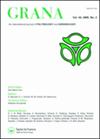Floral traits and chemical cues associated with rock bee (Apis dorsata Fabricius) for the host selection in West Bengal, India
IF 1
4区 生物学
Q4 PLANT SCIENCES
引用次数: 6
Abstract
Abstract In the present work, bee foraging plants were determined by palynological analysis of colony stored samples (honey and pollen) of Apis dorsata collected from southern West Bengal, India. Then flowering phenology and pollen morphologies were described to evaluate the forage preference of the bee species. In addition, chemical cues were analysed using gas chromatography-mass spectrometry (GC-MS). Foraging strategy of the bee species was profitable in that almost all the bee-visited plants were utilised for both nectar and pollen sources. The bee species became generalist visitor of several plants having diverse life form, flower characters and pollen morphologies. However, most of the bee-visited plants were of trees with synchronous type of flowering. Most plants had small-sized, yellow, cream and white coloured flowers and pollen was openly presented. We did not find any patterns in the morphological traits of bee collected pollen, though the pollen types were predominantly of medium sized with trizonocolporate apertural pattern and reticulate surface ornamentation. Floral volatile organic compounds (VOCs) of bee visited plants were also diversified. Compounds frequently found in the floral VOC bouquets were amphetamine-3-methyl; butane, 2-cyclopropyl; 2,3-butanediol; cyclohexan, 1-methyl-5-(1-methylethyl); d-limonene; methyl (2E)-2-methoxy-2-butenoate; phenol, 4-[2-(methylamino)ethyl]; phthalic acid, di(2-propylpentyl)ester; propanamide, N-(aminocarbonyl) and pyrrolo[1,2-a]pyrazine-1,4-dione, hexahydro-3-(2-methylpropyl). In conclusion, floral traits and chemical cues of plants influence the host selection specificity (to collect floral rewards) of the rock bees.印度西孟加拉邦岩蜂(Apis dorsata Fabricius)寄主选择的花性状和化学线索
摘要本工作通过对从印度西孟加拉邦南部采集的背蜂群体储存样本(蜂蜜和花粉)的花粉学分析,确定了蜜蜂觅食植物。然后描述了蜜蜂的开花表型和花粉形态,以评估蜜蜂对饲料的偏好。此外,还使用气相色谱-质谱法(GC-MS)对化学线索进行了分析。蜜蜂物种的觅食策略是有利可图的,因为几乎所有蜜蜂造访的植物都被用于花蜜和花粉来源。蜜蜂成为几种具有不同生命形式、花朵特征和花粉形态的植物的多面手。然而,大多数蜜蜂造访的植物都是同步开花的树木。大多数植物都开着黄色、奶油色和白色的小花朵,花粉是公开的。我们没有在蜜蜂采集的花粉的形态特征中发现任何模式,尽管花粉类型主要是中等大小的,具有三带孔结构和网状表面装饰。蜜蜂造访植物的花挥发性有机化合物(VOCs)也多样化。花卉挥发性有机化合物花束中经常发现的化合物是苯丙胺-3-甲基;2-环丙基丁烷;2,3-丁二醇;1-甲基-5-(1-甲基乙基)环己烷;d-柠檬烯;(2E)-2-甲氧基-2-丁烯酸甲酯;苯酚,4-[2-(甲氨基)乙基];邻苯二甲酸二(2-丙基戊基)酯;丙酰胺,N-(氨基羰基)和吡咯并[1,2-a]吡嗪-1,4-二酮,六氢-3-(2-甲基丙基)。总之,植物的花特征和化学线索影响岩蜂的寄主选择特异性(以收集花奖励)。
本文章由计算机程序翻译,如有差异,请以英文原文为准。
求助全文
约1分钟内获得全文
求助全文
来源期刊

Grana
生物-植物科学
CiteScore
2.10
自引率
11.10%
发文量
23
审稿时长
>12 weeks
期刊介绍:
Grana is an international journal of palynology and aerobiology. It is published under the auspices of the Scandinavian Palynological Collegium (CPS) in affiliation with the International Association for Aerobiology (IAA). Grana publishes original papers, mainly on ontogony (morphology, and ultrastructure of pollen grains and spores of Eucaryota and their importance for plant taxonomy, ecology, phytogeography, paleobotany, etc.) and aerobiology. All submitted manuscripts are subject to initial appraisal by the Editors, and, if found suitable for further consideration, to peer review by independent, anonymous expert referees. All peer review is single blind and submission is online via ScholarOne Manuscripts.
 求助内容:
求助内容: 应助结果提醒方式:
应助结果提醒方式:


